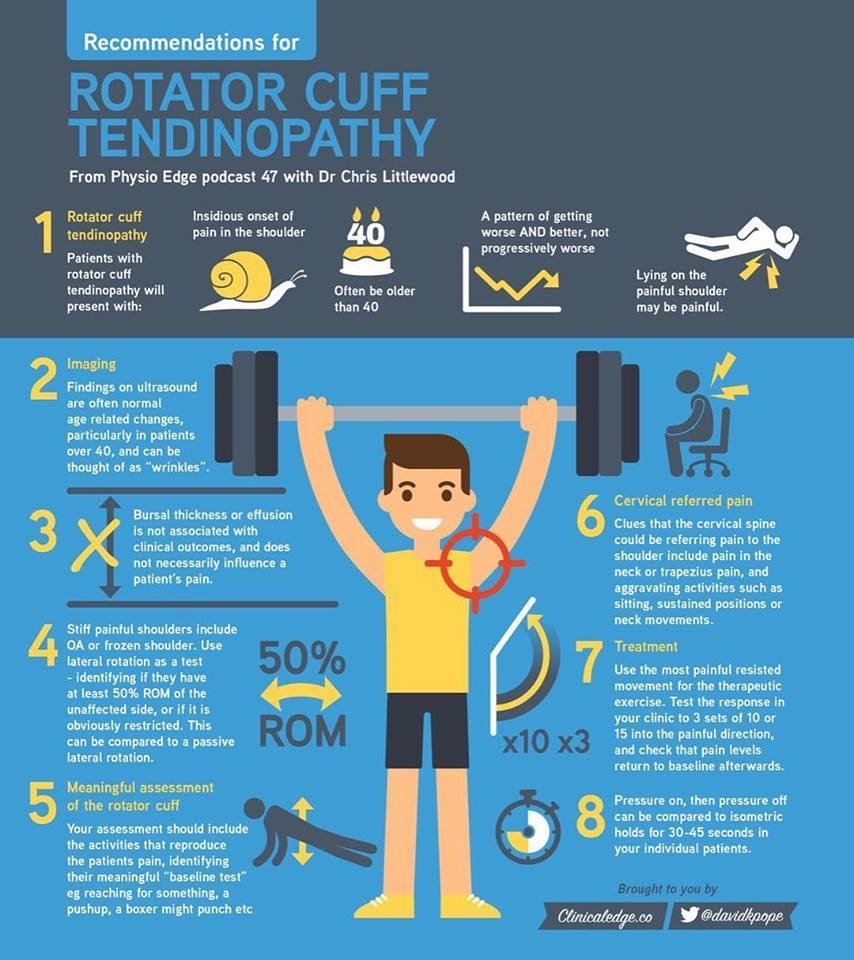What is rotator cuff tendon injury?
The rotator cuff muscles are a group of 4 muscles running from the scapula or shoulder blade, out to the top of the humerus, and play a vital role in controlling the position of the ball of the shoulder in its’ socket. Rotator cuff tendon injury is thought to be the most common cause of shoulder pain, especially in those aged over 40 years of age. Rotator cuff tendon injuries tend to present as a tendinopathy or tear to the tendon tissue of one or more of the rotator cuff muscles.
Rotator cuff tendinopathies are a tendon disorder much like patellar tendinopathy or tennis elbow where repetitive strain or overload has caused a weakening or degeneration of the tendon unit. Rotator cuff tendon tears on the other hand exhibit a focal disruption in the tendon unit of one or more rotator cuff muscles, and often occur from an acute trauma or repetitive microtrauma. Tear sizes will vary greatly which will have an impact on management.
Diagnosis
Diagnosis of rotator cuff pathology is achieved through a detailed subjective and physical examination. Imaging such as ultrasound or MRI may help with the diagnosis although research shows that many adults will have tendinopathy or tear on imaging despite a lack of symptoms. There are a range of tests to help differentiate between conditions and when combined with the clinical history an accurate diagnosis can be achieved.
Imaging such as ultrasound or MRI may help with the diagnosis although research shows that many adults will have tendinopathy or tear on imaging despite a lack of symptoms. There are a range of tests to help differentiate between conditions and when combined with the clinical history an accurate diagnosis can be achieved.
Those with rotator cuff tendon injuries often present with shoulder pain and weakness that may be worse at night, and aggravating activities often includes overhead lifting, lying on the side and reaching behind the back. Rotator cuff tendinopathies often present with:
- minimal resting pain
- duration of symptoms over three months
- often still have full shoulder range
- painful on resisted movements
Rotator cuff tendon tears on the other hand often present with:
- marked lack of shoulder range
- history of recent trauma
- may ache at rest
It is important to correctly diagnose sub-groups of rotator cuff tendon injury as this will differentiate management strategies.
Management
Management of rotator cuff tendon injury often involves a combination of manual therapy, exercise therapy and activity modification to maximise results. As the diagnosis of rotator cuff pathologies can be varied, so must the management be tailored to a patient’s needs.
Rotator cuff tendinopathy and smaller rotator cuff tears will generally react well to a graduated loading program of strength exercise as with other tendinopathies around the body (achilles, tennis elbow). Addressing any postural or biomechanical contributors to the development of the injury as well as ensuring adequate mobility of the shoulder joint and thoracic spine are vital in effective management of these injuries.
Anti-inflammatories may be indicated if there is the presence of swelling in the joint. Regarding partial or full thickness rotator cuff tears, if non-surgical management fails then imaging and surgery can be considered in collaboration with the multidisciplinary team. There is some conjecture over the timing of surgery for rotator cuff tears, but emerging evidence suggests that conservative management should be trialled first before considering surgical management.
If you have been experiencing shoulder pain and would like to get back to full shoulder function, please contact the physiotherapists at In Balance Physio and Pilates for a thorough musculoskeletal assessment.
Article by Kieran Watson

